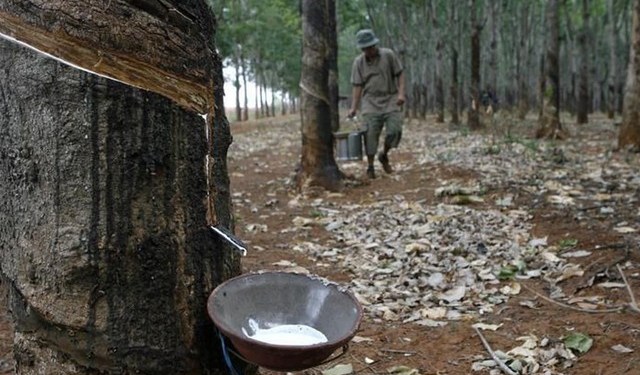Tire labeling law stage natural rubber is expected to pressure shock upstream
1.10. natural rubber Review of Trends
October Hujiao fluctuated amid slow pullback after a strong rebound in September, the second trading day after the National sharply pulled single-day gain of 4.51% and a record this year in the subsequent trading day Since late May, the high point of 25,958 yuan, after a few days but has not been able to break through the 26,000 yuan pressure line to maintain a high level consolidation Hujiao. On October 19 Hujiao 2.88% plunge in almost spit rally back to the beginning of the month. Since then, under the center of gravity of Hujiao shock move to the range of 24000-25000 yuan, 24,000 yuan below show some support. As of October 31, Hujiao index was close at 24,691 yuan, down 352 yuan, or 1.41% monthly, monthly line received negative cross.
October Day glue also presented rangebound slightly weaker trend in early shock upstream, October 5 274.3 yen hit a high point rebound since mid-August this year, approaching the end of May this year, along shock interval, but the subsequent uplink blocked fall, until October 24, the monthly the lowest point of 246.2 yen, thereafter gum pulled back slightly, as of October 31, the day plastic index closed at 255.3 yen, monthly, down 3.2 yen, a decrease of 1.23%.
Analysis of the reasons for signs of weakness in October, mainly the basic digestion producing countries to cut exports and purchasing and storage of double positive superimposed driver market in September, and enter the information surface is relatively flat in October, while the overall commodity market in 10 months demonstrated the weakness of a drag, plus natural rubber producing countries to increase annual production to increase pressure while domestic expected the car to the countryside also delay dishonored, so the final result in a the natural rubber concussion weak trend.
Figure 1: Hujiao index Japanese K Line Chart (Unit: yuan / ton)
Figure 2: the day plastic index Japanese K Line Graph (Unit: yen / ton)
Source: Man Huazhong permit Futures Research Department
2. Review the natural rubber viewpoint in October
In October quarterly, we believe that the fourth quarter, affected by seasonal factors and stimulus policies work together to affect the natural rubber at the bottom will become more apparent throughout the fourth quarter is expected to form a shock upward trend, but is expected to uplink main mainly in the range of 26000-27000 yuan, difficulty to reach 30,000 yuan highs still. On the other hand, the domestic auto production and sales in October boosted factors weakening market adjustment trend, but we think that natural rubber limited room for adjustment or the, 23500-24000 yuan below support stronger, on the one hand, there are the cars to the countryside is expected season, and the natural rubber industry policy still fermentation from the actual trend, Hujiao callback does off at 24,000 yuan integer for strong support.
3. The November natural rubber influencing factors
3.1. European labeling laws came into effect on
November 1st, 2012 EU tire label regulations EC1222/2009 will formally execute its provisions in EU sales of passenger car tires, light truck tires, truck tires, bus tires must affix a label to mark the tire fuel efficiency, wet pavement grip traction and road noise level. Implement tire labeling system, the core of the to promote green tire, the goal of 20% reduction in energy consumption in Europe in 2020. PAHs limit following the EU REACH regulations on tire again stringent restrictions.
3.1.1. European labeling laws ranging
From a time perspective, in 2009 the EU has been to make this provision, after more than two years of deliberation and preparation, until November of this year, began the specific implementation; range view, the European labeling laws covering almost all the car tire; indicators from the marked point of view, that the tire rolling resistance tire fuel economy requirements, wet road grip level of road noise levels in these three major performance standardized regulations performance three is the environmental and safety of the important indicators; view from the grading, marked with a black label different levels, similar to electrical products, energy-saving label, according to the tire rolling resistance, tire fuel efficiency parameter is divided into the AG seven grades: A representative of the best performance, G representative of the worst performance of the A-class and G-class tire fuel consumption varies between 7% to 8%; slippery road performance is also divided into Class A to Class G, the reference standard for the brakes to a standstill in the case of a speed of 80 kilometers per hour distance, grip Class A tire braking distance than the worst G-rated tire short of 18 meters; road noise levels in decibels by signs, the tire rolling noise decibel value directly on the label; punitive measures look like tire plant false data label acts, EU member states will impose hefty fines; from intent Analysis, on the surface, so that consumers can get the tire performance information is intuitive, which easily select what you want products, but also help to reduce energy consumption, substance is really a hidden trade barriers, thereby increasing the threshold of EU tire imports.
Figure 3: label method performance divide instructions
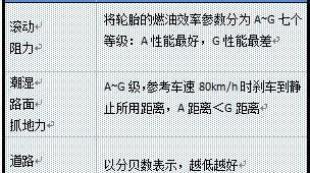
Figure 4: tire label icon
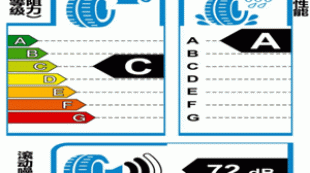
Source: Securities Futures Research Department
3.1.2. Corresponding policies of other countries
Level from a technical point of view, the high-performance green tire is the inevitable trend of development in the industry, and therefore the implementation of the region is not just a European labeling law. The United States six years ago, has passed a law containing the tire labeling requirements, is likely to be based on the fuel efficiency of the tire, traction and treadwear tire graded. In 2010, Japan introduced a voluntary tire labeling system will be mainly marked tire rolling resistance, wet road surface grip levels; tire exports 28% sold in the EU Korean tire labeling scheme, launched in 2011, the tire rolling resistance, wet road surface grip is divided into five grades 1-5; addition, Brazil is brewing enact similar tire labeling regulations.
Countries have joined the ranks of the labeling law, the intention behind it is to enable its tire exports in order to adapt to the pace of development of the tire industry in advance, regardless of the input constraints of the country’s local regulations, to reduce the impact of this hidden trade barriers on tire exports . European the region imports of tires in 2011 of about 10 billion euros, which accounted for the European tire consumption, 75% of the replacement tire sales of $ 307 million, the tire industry turnover reached € 470. The face of such a huge demand for the market, its introduction of standardized tire labeling law will largely change the competitive landscape of the European tire market, behind those low-end tires will be shut out, the global market share of the future green tires will increase by more than 15%.
3.1.3. Label Chinese tire industry
China is the world’s largest tire producer, its production accounts for about 1/3 of the world’s total production and production capacity continues to grow. Data show that from 2009 to 2011, the tire of China’s exports to the EU accounted for the proportion of the total tire exports were 15.15%, 16.31%, 18.43%, the amount of exports rose annually, accounting for 16.17%, 17.24%, 19.56 %. Domestic tire production base of Jiangsu Province, for example the 2011 Jiangsu tire exports to the EU accounted for 26.9% of exports last year, ranking first in the domestic.
Despite the large number of tire companies in China, but the scale of strength is weak. From the point of view of global tire enterprises operating income of the top 75, on the one hand, short-listed the number topped 2010 Mainland China tire companies shortlisted 20, 2011 rose to 24, respectively, 26.3%, 32% , followed by India, accounting for only 13%; contrary, the profitability of small-scale finalists Mainland China tire companies in 2010, the 2011 total operating revenues were $ 15.793 billion, $ 20.085 billion, or even less than the second an operating income of the French Michelin tires, only slightly higher than the third-ranked Goodyear Tire. Obviously China is only tire producing country, while the global tire industry is the leading enterprises in Japan, the United States, France and South Korea, In addition to challenges from emerging countries, India can not be underestimated.
Chinese tire enterprises are mainly in the low-end, in order to capture the market at a low price. The implementation of the labeling law in Europe 2012, three stages in 2015 and 2018, and, according to the Shanghai Tire & Rubber Group survey analysis of the results of the national truck tire, currently about 30% of the truck tire also reach the EU’s first stage scroll the minimum requirements of the resistance by 70% to less than the minimum requirements of the EU’s second stage rolling resistance; passenger car tire rolling resistance, mostly E F grade, temporarily up to the minimum requirements of the EU first stage, but a substantial proportion of The products can not achieve the minimum requirements of the EU’s second stage.
For the first phase, we are inclined to think the impact will not be too large tires and natural rubber. Analyzed by the above statistics, First of all, the affected domestic tire truck tire for 30% of non-compliance, small car tires, tires disaggregated data from China’s export in 2011, the truck and bus tire exports mainly the United States, UAE and Russia, and from January to May this year, the card bus export three countries the United States, the United Arab Emirates and Saudi exports of the top 20 in Britain is the only part of the EU countries, the 2011 truck and bus exports 36,700 tons, accounting for only 1.8% of exports so, exports in January-May this year, the number of year-on-year decline of 16.4% to 1.09 million tons, therefore single from the situation of truck tires, the first phase of the labeling law is expected to have limited impact on exports. In addition to the analysis of the European market to account for 80% of the replacement tire market, for example, passenger car and light truck tires is the main consumer of the European tire, heavy truck is a relatively small proportion.Second, the the tires share of 30% of the non-compliance will be remaining standards enterprises to increase supply and the gap is filled, the operating rate of the tire companies in 8-9 into the market have the ability to increase production to fill this part of the share of exports.
The second stage and the third stage of the labeling law, did not highlight the domestic tire outlet pressure, tire companies have technical adjustments to adapt to the new requirements. Situation one enterprise is not up to 3-5 years to complete technical update, the standard enterprise can not be completed capacity expansion, and then in 2015, 70% of truck tires will not be compliance, and the proportion will reach about 80% of the passenger car tire coupled with our truck all steel radial tire major domestic tire enterprises the main source of profit, then the impact will be more than 50% of the tire industry earnings, domestic natural rubber demand will slow down. But we are inclined to think that within 3-5 years, the domestic tire industry will carry out industrial restructuring, technology will gradually increase the domestic steel truck tire technology has been in the ranks of the leading international and technology refresh cycle trend short, is expected to 2015, the load tires 70% the proportion of non-compliance will be reduced to about 30% the passenger tire compliance rate will rise to 70-80%, and will have a favorable impact on the demand for domestic natural rubber.
Comprehensive analysis of labeling laws impact on the market, is expected in the first phase of the labeling law purposes, the extent of the impact of China’s tire exports, or less than 2%, little overall impact on the domestic natural rubber, but the second and third stages if the domestic transformation not meet the requirements, it will form a heavier impact on domestic tire enterprises, However, If you stand on a global perspective, even if Chinese exports affected, but as long as there is demand, there will be other areas of the tire consumer formation make up, so the label fundamentally does not affect the qualitative situation of global consumption of natural rubber, like the case of special protection, more investors from the psychological formation of domestic tire companies to form the test, but the impact of global supply and demand of natural rubber little.
Figure 5: The annual production and export volume of Chinese tires (one hundred million)
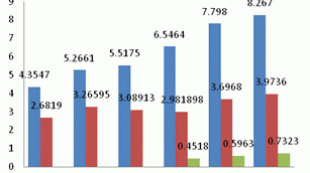
Figure 6: Chinese tire enterprises global ranking
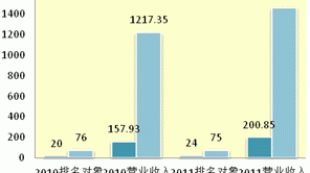
Source: WIND Securities Futures Research Department
European labeling law for the purposes of, resulting in some of the domestic tire companies to seek a breakthrough in advance caliber. For example, double the money stock after July 1 of this year already labeling; Aeolus tire propped up sales to meet EU standards; S Giti Tire is also known to be able to reach EU standards, while the second phase is still under assessment green passenger car tires; Shandong Linglong Group called research and development has reached the requirements of the EU labeling law, with Michelin, Dunlop fairly than the existing ordinary level tire rolling resistance reduced by 30% to reach a world-class car factory matching requirements, reduce car fuel consumption of 3% -5%.
Read part 2: http://globalrubbermarkets.com/2387/monthly-digest-china-natural-rubber-market-in-october-part-2.html


